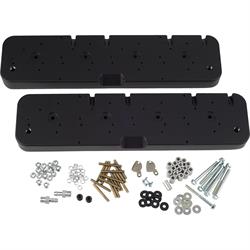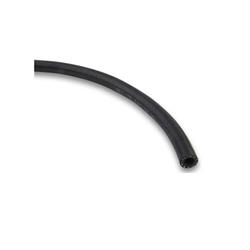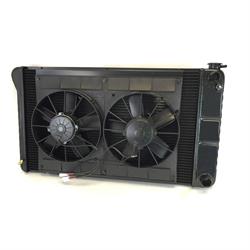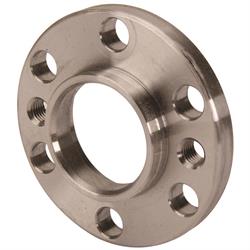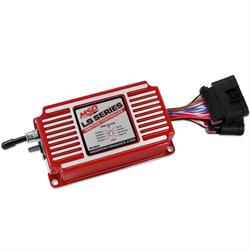LS Swap How-To Guide
What do you need for an LS swap?
2022 will mark the 25th anniversary of GM’s Gen III small block, known to most of us as the “LS” engine, landing under the hood of the ’97 Corvette. Hot rodders picked up on them almost immediately as a cheap, plentiful source for bulletproof horsepower. But even though we’re almost a quarter century into the LS swap trend, they are still confusing to many of us.
There are, in fact, a few things that are different and require some outside the box thinking when compared to the old-school small and big blocks that we’re all familiar with. This article is meant to serve as a guide to some of those differences and a way to start your research. There are too many specific applications and unique combinations for this to be a comprehensive “everything you need to know” article, so instead this article will serve as a guide for those who haven’t done an LS swap before. These are the things you need to be aware of, some solutions that can be found in the Speedway Motors catalog, and a guide as you research and select parts for your exact combination.
What Mounts and Adapters do I Need?
LS motor mounts are different from the three-bolt mount that we’re used to seeing on the old small and big blocks. Fortunately, GM left the mount bosses on the block in more or less the same place, and Speedway Motors offers adapters to accommodate almost any swap you can dream up. Most often these consist of a plate that adapts the familiar three-bolt mount to the LS block. Changing the location of the three holes relative to the block allows the engine to be moved forward and back in the chassis to accommodate most applications. There are also sliding mounts that offer even more adjustment.
What Oil Pan Will Fit my Chassis?
If you’re using an LS sourced from the junkyard, the stock oil pan might be a problem. GM designed the OE pans around the late model Corvette, truck, SUV, or whatever other application the engine was pulled from. As you can imagine, these pans are not always happy in a muscle car or hot rod. Most commonly at fault is the depth of the sump. The bottom where the pickup goes often hangs too low, especially for a lowered car. The depth at the front where the pan sits above the crossmember can also be too deep and not allow the engine to sit low enough in the chassis.
Fortunately, there are aftermarket alternatives that will work in just about any application. Speedway Motors offers a variety of pans in various configurations to fit just about any chassis.
The issue of oil control under extreme conditions can be a problem with any engine, and LS engines are no exception. As modern suspension and performance technology allows us to push our old cars in new ways, keeping the pickup submerged in oil under hard cornering, braking, or acceleration can be a real issue. Engines don’t live long when the pump starts to suck air instead of oil, and we have a ventilated oil pan hanging on our shop wall that proves this point quite nicely. GM added a dry sump to the LS7 used in Z06 Corvettes precisely for this reason. A relatively low-cost alternative to solve this problem is the Holley baffle kit. Trap doors help to hold the oil over the pickup where it belongs and offers a little piece of mind before hitting the autocross or road course.
How do I Mount the Accessories?
Like the oil pan, the GM factory accessory drive layout was not designed to work within the confines of a hot rod or muscle car engine bay. There is almost always a pump, compressor, or alternator living where a frame rail or fenderwell wants to be. Often, it’s the low-mounted power steering pump that causes the most trouble. Fortunately, Speedway Motors offers a wide variety of solutions to fit just about any application.
In general, there are three different crank pulley depths that determine what bracket kit you will use. Commonly referred to as the Corvette spacing, Camaro/F-body spacing, and truck spacing. The Corvette is the shortest and is therefore preferable if space is an issue. The Camaro spacing is about .750” farther from the face of the block, and the truck spacing is about 1.5” longer. It helps to know which you have before you start shopping for accessory bracket kits.
Do I Need a Special Radiator?
On most LS water pumps, the inlet and outlet are both on the passenger side. The upper hose is also smaller than that on an old-school small or big block at 1-1/4”. So, LS-swap radiators are built with this in mind and most feature appropriately sized inlet and outlet ports on the passenger side tank. The thermostat on LS engines is on the water pump, and the relatively low position necessitates some way to keep air pockets and the resulting hot spots out of the top of the engine. So, LS engines have steam lines that vent any trapped air back into the flowing coolant. The radiator tank is a great place to attach a steam line, so most LS-swap radiators also feature a port for this purpose. Afco and DeWitts both offer beautifully crafted, direct-fit LS swap radiators for many different applications.
We used a DeWitts direct fit radiator when we dropped the 6.0 LS into our Project Chevelle. It fit exactly as it was supposed to and the black finish made it look like it grew there at the factory. It is a beautiful radiator and it’s almost a shame that it blends in so well and doesn’t get noticed.
You may have noticed that many of the direct fit LS-specific radiators carry a pretty high price tag. If you’re a budget builder looking for a lower cost alternative, Speedway Motors has a handy little adapter that allows you to use a universal radiator. It adapts the diameter of the upper hose and offers a port to attach the steam line. It’s also offered in a kit with one of our universal double pass radiators. These are excellent radiators that can be had for a fraction of the price of most LS swap radiators.
What Headers Should I Use?
Of course LS engines require dedicated headers. The good news is that the exhaust port layout on the cylinder head allows for a header bolt situation more like a big block Chevy and less like the pesky small block. More good news is that the aftermarket has come up with an LS swap header to accommodate just about any chassis you can dream up. There are also more universal options available like the excellent Speedway Motors Tru-Ram manifolds, Speedway Motors Tight-Fit headers and the Hooker cast manifolds. Some chassis even allow the factory manifolds to be re-used. If you need some bad news, junkyard LS engines are infamous for having broken exhaust bolts that require delicate surgery to extract. Expect to deal with this, especially if you’re purchasing a high-mile or early engine.
What Transmissions Work with an LS?
The engineers at GM did us a favor and (mostly) retained the same bellhousing bolt pattern on the back of the block that small and big block Chevys had been using for decades. The dowel pins are in the same spot and 5 of the 6 bolt holes are as well. However, most LS engines have a different offset between the crankshaft and the face where the bellhousing bolts up when compared to an old school small or big block. The crank flange where the flywheel or flexplate attaches is about .400” shorter, or farther away from the face where the bellhousing bolts up.
If you’re adapting a manual transmission, use the appropriate bellhousing to make sure that the input shaft is in the right place relative to the pilot in the crankshaft. If you’re running an older transmission with the GM 4-bolt pattern or a Tremec TKO, use an LS-specific bellhousing like the OER or the Quick Time offerings. Speedway Motors also offers a few kits with everything you need ready to go. A late model T-56 or Tremec Magnum can use an OE-style bellhousing.
If you’re more interested in an automatic, there are plenty of possibilities here as well. If the engine is still mated to the 4L60E or 4L80E that it came with from the junkyard, then the solution is simple and you just need to use an ECU with a transmission controller. If you wish to mate your LS to an old school automatic like a TH350, there are flexplates and spacers available, but you need to be aware of a few critical dimensions. First, that .400” difference between the bellhousing and crank flange will necessitate a dished flexplate or spacer ring. Most aftermarket dished flexplates also feature a dual pattern to allow use of a 4L60E torque converter with an 11.066” bolt circle or the TH350 or 700R4 converter with a 10.75” bolt circle. It's important to note here that a 4L80E is a bit different, as it will use the same 11.5" bolt pattern as a TH400. Also note that the pilot on a non-LS converter is about .350” shorter than that on an LS converter. A crank sleeve adapter may be used here to make up the difference.
One notable exception to the rule is the ’99-'00 LQ4 6.0. These use a “long” crank flange and will use a flat flexplate without a dish or spacer.
What do I use for an ECU-and What if I Want to Keep my Carburetor?
Now that the engine is bolted in place, we have to acknowledge the elephant in the room. The number one source of confusion and head scratching when planning an LS swap is how to make 21st century engine management live happily in a vintage engine compartment. It’s easy to hook up fuel lines and a throttle linkage to a carb, but looking at the wiring mess hanging from that junkyard LS engine can be a bit alarming. Fortunately, the aftermarket has solved this problem and made it almost as simple as hooking up that old carburetor.
Some will opt to have their stock harness and ECU modified to work in their application. We prefer an aftermarket solution like the Holley, or FiTech. When ordered with the harness, these become a plug and play operation. Most also come with a touch screen interface to make setup, tuning, and troubleshooting easy.
If you love LS engines but aren’t quite ready to give up your carburetor, never fear. There are a few options available that match old school with new tech and they work very well. Edelbrock offers kits that use a dual-plane Performer RPM intake as well as a single plane Victor Jr.. Holley also offers a variety of intakes and MSD makes a stand-alone ignition box to spark the distributorless ignition without the need for an ECU. It’s worth noting that these setups tend to be pretty tall, so if you already have hood clearance concerns, this might not be the ticket for you.
Before purchasing any of these options, it helps to know what reluctor wheel and cam sensor you have. The reluctor is a ring on the crankshaft that is read by the crank sensor. There are both 24x and 58x reluctors and it’s important that you match your ECU to the reluctor that it’s designed to work with. Fortunately, it’s easy to tell which one your engine has simply by looking at the crank sensor (hidden behind the starter). If the sensor is grey, then it’s a 58x reluctor. A black sensor means that it’s the earlier 24x. A 24x reluctor will be paired with a 1x cam sensor, while a 58x will pair with a 4x cam sensor. Some aftermarket ECU’s are designed to work with a specific reluctor and cam sensor combination. Others are more universal and allow you to select your combination during setup when the unit is hooked up in the car.
This all sounds complicated, but it’s pretty simple to figure out, especially if you know the exact year of your engine and what car or truck it came out of. Aside from a few important distinctions, LS engines and components are fairly universal, just like the beloved Gen I small blocks that came before them.
Regardless of what path you choose for an ECU, be sure to carefully follow the manufacturer’s recommendations when it comes to the wiring. Hook it up to the battery exactly as they describe, using the recommended wire gauges. When in doubt, go heavier on the wire. Soldered connections wrapped in heat shrink are better than cheapy crimp connectors. It may sound like we’re being preachy here, but this author has spent too many late nights in the shop diagnosing mysterious gremlins in an LS swap, only to find a wiring shortcut to be at fault. You will be in a hurry when you get to this point. Don’t give in to the temptation to cobble the wiring together in your haste to hear your creation fire up. A little care and extra attention to detail here will save hours of head scratching later on.
Do I Need to Upgrade the Fuel System for an LS Swap?
A fuel injected, naturally aspirated LS engine will need a good EFI fuel pump and will generally want 58 pounds of fuel pressure. Compared with the 5-7 pounds that your carbureted small block was running, that’s a significant jump and requires dedicated hardware.
Speedway Motors offers a handy fuel filter and fuel pressure regulator combination that can be a real lifesaver for an LS swap fuel system. Not only is it a filter and regulator in one unit, it’s also preset at the appropriate fuel pressure and provides a convenient place to hook a return line without running it all the way from the fuel rails back to the tank. We installed one in our LS3-powered truck and you can see what that looks like in our Tech Talk video.
If you need a pump as well, we offer the filter and regulator in a kit with a Walbro in-line pump as well as the clamps and fittings you will need for mounting and plumbing. There is also an in-tank version as well as a line of direct-fit tanks that are set up for an in-tank pump. We used one of these tanks in our Project Chevelle and it fit well and has performed flawlessly.
When it comes to plumbing, it should be noted here that parts-store hose clamps and old rubber fuel hose are not going to cut it at 60 psi. Hardlines with AN fittings work well here, as well as push-on hose and fittings. We’ve also had great luck using Earl’s Vaporguard hose and fittings. It’s a breeze to work with (no wrestling the hose over the barb like a push-on) and it won’t be damaged by modern fuels and blends using ethanol.
How Can I Make my LS Look Better?
LS engines are great bang for the buck performance engines. But, if you’re looking for a downside you may find it in their appearance. The plastic intake manifolds, coils on the valve covers, and abundance of wiring can make these engines look a little out of place under the hood of a vintage car. Some don’t care and embrace the function over form aesthetic, but if this is something that matters to you, there are plenty of creative solutions to dress up an LS engine.
To address the coil pack issue, there are kits to relocate the coils to a more discreet location. Some leave them in place on the valve covers, they just cover them up. If you’ve relocated the coils, you may consider some better-looking valve covers, or adapters to use your favorite old school valve covers to further blend the late model engine into your vintage engine compartment.
Where Do I Get More Information?
We haven’t gone very deep into the huge variety of Gen III, IV, and V engines out there and how to shop and select the best one for your application. Our friends at Super Chevy put together a great overview of the engines and changes over the years that’s worth a read. As for shopping, these engines are similar to most other OE equipment in that the more common variants tend to be cheaper, while the more exotic and powerful engines like the LS7, LS9, and LSA will command a premium. If you want to skip the guesswork and uncertainty of buying a salvaged engine, there are plenty of new crate engines available from Speedway Motors that offer proven power from a brand-new engine and many are even paired with the correct ECU.
There’s a lot to unpack here, and we haven’t even gone into the specifics of the more exotic variants like the dry-sumped LS7, supercharged LS9 and LSA, or the 2013-up Gen V LT engines. At the end of the day, the best strategy is to decide what engine you want and can afford, then center your research around that engine and the chassis you plan to use it in. You don’t need to know everything about late model GM performance. If you confine your research to your specific application, you will be surprised how simple it is. As always, if you find yourself stumped, a call to 800-979-0122 will connect you with our knowledgeable tech team that will be happy to help you out.








